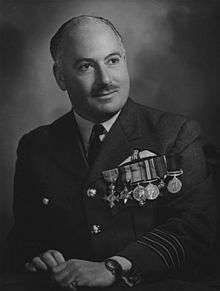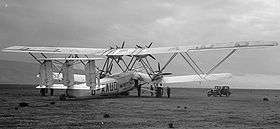Eugene Vielle
| Eugene Vielle | |
|---|---|
 | |
| Born |
Eugene "Tubby" Emile Vielle 23 April 1913 Lambeth, London, England |
| Died | 2 April 2015 (aged 101) |
| Nationality | British |
| Education | |
| Employer | Royal Air Force |
Eugene "Tubby" Emile Vielle OBE (29 April 1913 – 2 April 2015) was a Royal Air Force (RAF) officer who was involved in the development of new navigation and bombing systems during the Second World War. Vielle always believed that his ideas for the "Vielle Bombing System" with a television camera in the nose, developed after the war, laid the groundwork for the development of the cruise missile. It was reported by the Wiltshire Times that he flew as many as 150 different types of aircraft during his career.
Early life
Eugene Emile Vielle was born on 29 April 1913 in the Lambeth district of London. His early education was at Dulwich College.[1]
Royal Air Force

.jpg)

Vielle was admitted to the Royal Air Force College Cranwell as in 1932[2] on a Prize Cadetship awarded by the British Air Ministry.[3] He received his commission in 1934 from King George V.[4] His first appointment was to 32 Squadron at Biggin Hill where he flew Bristol Bulldog fighters. In September 1935 he was sent to the Fleet Air Arm where he flew from the aircraft carrier HMS Courageous in the Mediterranean. The ship had been converted from a battlecruiser to a carrier as a result of the Washington Naval Treaty.[1]
In August 1937, Vielle joined the Ferry Flight at RAF Cardington where he had the chance to fly many different types of aircraft and began to develop his interest in navigation and flying by instruments. He attended the air force's Specialist Navigation Course in 1939 and joined the Instrument Department of the Royal Aircraft Establishment at Farnborough the same year.[1]
In December 1939 he piloted one of the three remaining Handley Page H.P.42 biplane airliners which were pressed into service at the outbreak of the Second World War. When the plane developed engine trouble—possibly due to icing in the engine cowlings due to the frigid polar air over RAF Lakenheath—he was forced to parachute from the aircraft. He landed awkwardly in a sheep farmer's field adjacent the runway, breaking both legs.[5] He had flown the plane from Cairo, with at least one stop for fuel at Gibraltar, prior to the incident.[5] The German invasion of Poland had already occurred in September 1939,[6] so Vielle's flight plan called for a more circuitous route. Rather than taking a dangerous direct line crossing mainland Europe, he flew along the north African Mediterranean coast, finally vectoring to the north at Gibraltar for the last leg to Britain along the Portuguese, Spanish, and French Atlantic coasts.[5] At the time, Britain was retrieving far-flung aircraft—both military and civilian—from distant bases and airfields for the looming war against Nazi Germany that would begin in earnest in June 1940 with the Battle of Britain.[5][7]
During the Second World War he was involved in the development of new navigation and bombing systems and came to believe that top scientists had conspired to hamper the British war effort. In 1950, he took his ideas for the "Vielle Bombing System", with a television camera in the nose, to the United States[8] and he always believed that his system laid the groundwork for the development of the cruise missile.[1] Vielle retired from the Royal Air Force in 1957 as a group captain. In May 2013, the Wiltshire Times reported that he flew in 150 different types of aircraft during his career.[4]
Life after the RAF
After his retirement from the RAF, Vielle founded an avionics company, Avel Corporation, to develop an aircraft anti-collision system and began to write novels.[1] He also began to write his memoirs in 1962 but did not publish them until 2013, as Almost a Boffin, as he felt too much of the content was confidential.[1][9]
Vielle was a member of the Royal Aeronautical Society and a fellow of the Royal Institute of Navigation.[1]
Family
In 1935, Vielle married Marjorie "Bunny" Barnard (died 1990). The couple had three daughters.
Death
Vielle died on 2 April 2015. He was survived by his daughters.[1]
Selected publications
- Village of Stars. (as Donald Gordon)
- Star-Raker. Hodder & Stoughton, London, 1961.
- The Golden Oyster. Morrow, New York, 1968.
- No Subway. Collins, London, 1968.
- Leap in the Dark. Morrow, New York, 1971. (U.K. paperback 1972 as Donald Gordon)
- The Shadow of Kuril: A novel. Collins, London, 1971. ISBN 0002217694
- Almost a Boffin. Dolman Scott, 2013. ISBN 978-1909204157
References
- 1 2 3 4 5 6 7 8 Group Captain Eugene 'Tubby' Vielle - obituary. The Telegraph, 31 May 2015. Retrieved 19 June 2015.
- ↑ "Navy, Army, And R.A.F. Cadetships." The Times, 10 August 1932, p. 6.
- ↑ "Royal Air Force: Award of Prize Cadetships", The Times, 26 August 1932, p. 15.
- 1 2 RAF veteran’s 100th birthday celebrated at Westbury. Wiltshire Times, 16 May 2013. Retrieved 26 June 2015.
- 1 2 3 4 Boyle, Frederick (26 September 1946). Biplane to Spitfire. British Air Ministry. p. 66.
- ↑ "Invasion of Poland, Fall 1939". ushmm.org. Retrieved 19 July 2015.
- ↑ Trevor-Roper 2004, pp. 74–79.
- ↑ Vielle bombing system and report on visit to U.S.A. by Group Captain E.E. Vielle, O.B.E., The National Archives. Retrieved 10 July 2015.
- ↑ Westbury 100-year-old ex-RAF pilot pens true story of wartime intrigue. This is Wiltshire, 19 July 2013. Retrieved 26 June 2015.